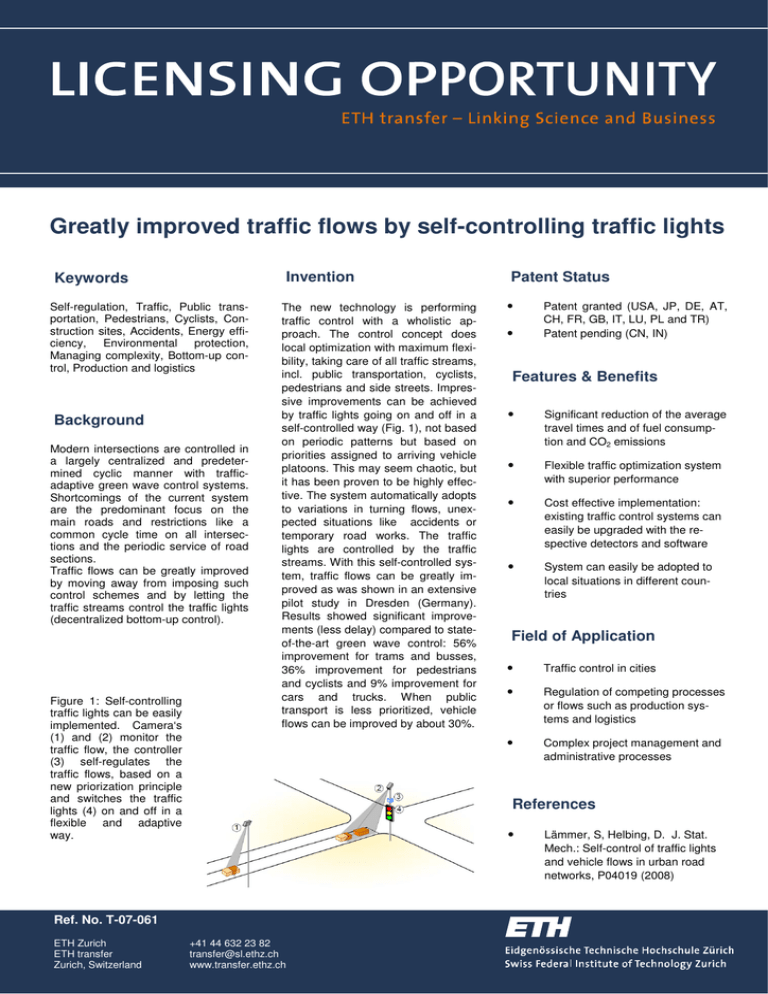Greatly improved traffic flows by self
advertisement

Greatly improved traffic flows by self-controlling traffic lights Invention Keywords Self-regulation, Traffic, Public transportation, Pedestrians, Cyclists, Construction sites, Accidents, Energy efficiency, Environmental protection, Managing complexity, Bottom-up control, Production and logistics Background Modern intersections are controlled in a largely centralized and predetermined cyclic manner with trafficadaptive green wave control systems. Shortcomings of the current system are the predominant focus on the main roads and restrictions like a common cycle time on all intersections and the periodic service of road sections. Traffic flows can be greatly improved by moving away from imposing such control schemes and by letting the traffic streams control the traffic lights (decentralized bottom-up control). Figure 1: Self-controlling traffic lights can be easily implemented. Camera‘s (1) and (2) monitor the traffic flow, the controller (3) self-regulates the traffic flows, based on a new priorization principle and switches the traffic lights (4) on and off in a flexible and adaptive way. The new technology is performing traffic control with a wholistic approach. The control concept does local optimization with maximum flexibility, taking care of all traffic streams, incl. public transportation, cyclists, pedestrians and side streets. Impressive improvements can be achieved by traffic lights going on and off in a self-controlled way (Fig. 1), not based on periodic patterns but based on priorities assigned to arriving vehicle platoons. This may seem chaotic, but it has been proven to be highly effective. The system automatically adopts to variations in turning flows, unexpected situations like accidents or temporary road works. The traffic lights are controlled by the traffic streams. With this self-controlled system, traffic flows can be greatly improved as was shown in an extensive pilot study in Dresden (Germany). Results showed significant improvements (less delay) compared to stateof-the-art green wave control: 56% improvement for trams and busses, 36% improvement for pedestrians and cyclists and 9% improvement for cars and trucks. When public transport is less prioritized, vehicle flows can be improved by about 30%. • • Patent granted (USA, JP, DE, AT, CH, FR, GB, IT, LU, PL and TR) Patent pending (CN, IN) Features & Benefits • Significant reduction of the average travel times and of fuel consumption and CO2 emissions • Flexible traffic optimization system with superior performance • Cost effective implementation: existing traffic control systems can easily be upgraded with the respective detectors and software • System can easily be adopted to local situations in different countries Field of Application • Traffic control in cities • Regulation of competing processes or flows such as production systems and logistics • Complex project management and administrative processes References • Ref. No. T-07-061 ETH Zurich ETH transfer Zurich, Switzerland Patent Status +41 44 632 23 82 transfer@sl.ethz.ch www.transfer.ethz.ch Lämmer, S, Helbing, D. J. Stat. Mech.: Self-control of traffic lights and vehicle flows in urban road networks, P04019 (2008)


